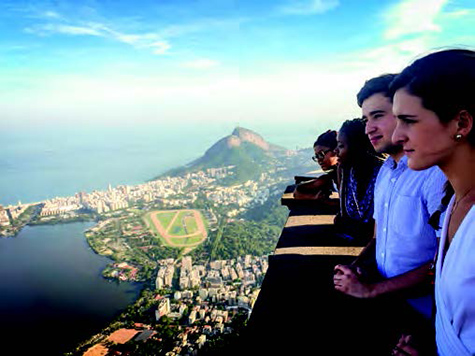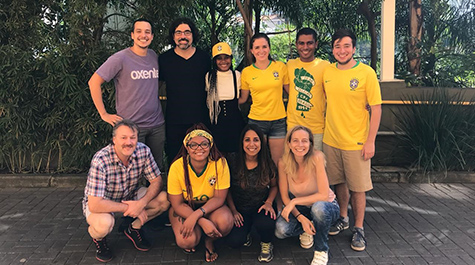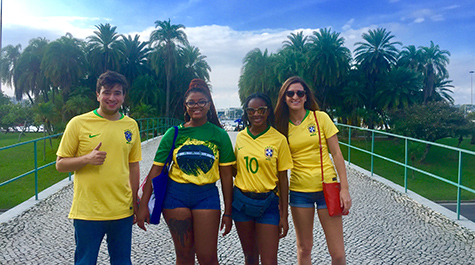Fabricio Prado Introduces W&M to his Native Brazil
by Paulina Farley-Kuzmina '20
Tucked away in the corner of Blair Hall’s third floor, the office of history professor Fabricio Prado has walls lined with books about the history, politics, and governments of South America. Born and educated in Brazil, Prado has a passion for the culture and history of Rio de Janeiro that is palpable from the moment you meet him. Over the past two and a half years Prado has channeled his enthusiasm for Brazil to help create the first William & Mary faculty-led summer program in South America offered on a yearly basis. A handful of students in addition to Prado traveled to Rio de Janeiro for four weeks in June and July. The program required two three-credit courses, one on the history and culture of Rio de Janeiro taught by Prado, and the other being the first Portuguese language course to be offered through William & Mary in over a decade.
DESIGNING THE EXPERIENCE
The goal in mind when developing this program was to offer a study abroad experience in South America that offered an overview of the local culture and language as well as explored the history that connects Rio de Janeiro to the rest of the Americas, Asia, Africa, and Europe. Both the courses taught and the numerous excursions over the course of the program offered a unique interdisciplinary look at Rio de Janeiro.
“I chose Rio de Janeiro because it brings together several fields and perspectives. There is so much overlap that would attract students from different fields and with different interests, as well as in terms of faculty that can lead it,” Prado said. “I wanted to create something that is sustainable, something that is not just attached to me as a professor.”
Besides the historical aspect of the program, the culture of South America is relevant to Hispanic studies and Latin American studies, according to Sylvia Mitterndorfer, Director of Global Education at the Reves Center. “The Rio program addresses an unmet need, is made possible by William & Mary faculty expertise and research, aligns with university curricular priorities, and signals the importance of students having opportunities to study in South America,” Mitterndorfer said.
As one of the largest ports that received and traded slaves during the 18th century, Rio de Janeiro is also a fascinating destination for students in Africana studies. Environmental sciences or biology students could be interested in the ecosystems of the Amazon, and the rapid industrialization and subsequent pollution there.
“Rio is a good place to build relationships for the university and at the same time is an ideal location from which to branch out to other areas and grasp some of the cultural and ecological diversity of the country,” Associate Professor of Anthropology William Fisher said. Fisher was one of the many faculty involved in organizing the trip. “The program has already begun this process and each ensuing year will enable faculty course leaders to build on the experiences of previous years.”
IMMERSIVE LEARNING
After the students finished their Portuguese classes in the morning, they would break for lunch and proceed to visit various museums, schools, or historical sites for Prada’s history and culture course.
He provided an interactive experience by lecturing on site at whatever location they were at that day.
“My point was to make the history come alive,” Prado said. “Why teach in a classroom when the historical site is so close?”
The afternoon trips included visits to the National Archives, Sugarloaf Mountain, the Botanical Gardens, and various museums. The group also took a day trip to Petrópolis, which is the summer home for the Brazilian royal family, and a weekend trip to Paraty, a colonial port preserved much like Williamsburg, and known as the place where much of Brazil’s diamonds and gold were smuggled out.
Students ventured out into the city more during their down time as they become more comfortable interacting in Portuguese, with concerts and dancing being popular activities. A notable part of the study abroad experience was watching Brazil’s first match of the 2018 FIFA World Cup.
“We watched the game with 5,000 other fellow Brazilians. That was a moment where we all felt the contagious joy and emotions of soccer in Brazil. It was a very deep experience for the students because we don’t have that here,” Prado said.
MAKING THE VISION A REALITY
Although groundbreaking on multiple levels, this program did not evolve easily. Since the initial conception of the pro- gram in 2016 Prado has worked with the Reves Center, other faculty members, and local partners in Brazil to build a study abroad experience that encapsulates the complexity of Rio de Janeiro.
One year before the program was ready, Prado and Molly DeStafney, Associate Director of Global Education Pro- grams at the Reves Center, conducted site visits to the hostel where the students would be staying, the classroom spaces where students would take their language classes, and the surrounding neighborhoods to make sure that everything was safe and accessible. For the program, William & Mary partnered with the Council on International Educational Exchange (CIEE). CIEE not only facilitated site visits, but also managed the Portuguese classes. Prado and DeStafney met with the local representatives during that initial visit.
“I wanted to deconstruct stereotypes about Brazil. Usually when people think about Latin America or other ‘exotic’ parts of the world they think of danger, revolution, or beaches. They don’t think about a giant metropolis with thriving business sectors or super industrialized cities,” Prado said.
Prado explained that there were various reasons why South America was not a region to which William & Mary offered summertime faculty-led trips until this past year. The top priorities with the university were safety concerns and economic instability in parts of the continent. However, by working with the Reves Center and local partners in the city, Prado was able to build a program that improved security and stability for the students.
“Although faculty were committed to choosing a site in Brazil, Rio was not an easy choice. There are other places that more closely reflect faculty research interests and experience, and Brazil is such a diverse and large country that Brazilians often refer to it in the plural,” Fisher said. “In the end, Rio suits because it has a lot of experience in receiving outsiders, and it has world class educational and artistic institutions.”
In a more abstract sense, as the Latin American studies department developed and faculty with more diverse interests were hired, the interest in study abroad opportunities has increased.
“For years now the Latin American Studies Program has focused on expanding our offerings on Brazil,” notes John Riofrio, Director of Latin American Studies and Associate Professor of Hispanic Studies. “We have felt, for a long time that you can’t adequately understand the intricacies of Latin America without considering the role that Brazil has played and continues to play on the world stage. It is our hope that, along with recent experiments in offering Brazilian Portuguese here at William & Mary, we will continue to make strides in fully integrating Brazilian Studies into our already robust Latin American Studies Program.
DEVELOPING THE PROGRAM’S FUTURE
William & Mary’s summer in Rio de Janeiro was an eye-opening experience not only for the students, but Prado admits for himself as well. He explains that having to guide and teach the students through the city gave him a whole new perspective on Rio de Janeiro.
“For the first time I understood Rio in all of its complexity,” Prado said. “I was thinking about the city as a classroom and as a site of memory and history.”
In the future, Prado anticipates that the program will grow in number for both student participants and faculty members leading the trip. He also hopes that the program will attract a varied group of students.
“I hope to see this study abroad program keeps growing and help consolidate the global outlook we have now at William & Mary.”
 Skip to main content
Skip to main content



